After testing and reviewing filament dryers and dry boxes over the years, we are compiling a detailed guide in this category. The expectation that such inexpensive devices may significantly improve filament and 3D print quality is thrilling. Is it a MUST-have device for my 3D printers or not? Keep reading, and we will find out. Also, as usual, we will keep adding more such devices for comparison and feature the newest solutions.
This Guide Covers
- Why are Filament Dryer Boxes Needed?
- Moisture Absorption – Hygroscopicity
- The Best Filament Dryers
- SUNLU S2
- Polymaker PolyDryer NEW
- EIBOS
- Creality Space Pi X4 NEW
- Sovol SH01
- Eryone M2
- DIY Solutions and Innovations
- Conclusion
Why are Filament Dryers Needed?
Until now, we used to keep all filaments in sealed plastic bags with a piece of a desiccant dehumidifier and were generally happy about it. Of course, in a few years, filament quality in some spools became degraded due to general mishandling. Plastic bags either didn’t get sealed properly, were micro-pierced by a sharp filament end, or the silica gel stopped working, and we had no idea about it.
In extreme cases, our filament made a popping noise during extrusion, and some visible evaporation occurred. This is the source of uneven surfaces on the prints. When the water is heated, it boils and evaporates, leaving micro craters on the extruded filament and printed surfaces.
The opportunity to reverse the process and get the quality of the material back is very welcoming. This is where filament dryers may come to the rescue.
Moisture Absorption – Hygroscopicity
In our previous article, “How to Revert Filament Moisture Absorption,” Curry Lin explained how it works in detail. He even featured a chart showcasing how some filaments are more hygroscopic than others.
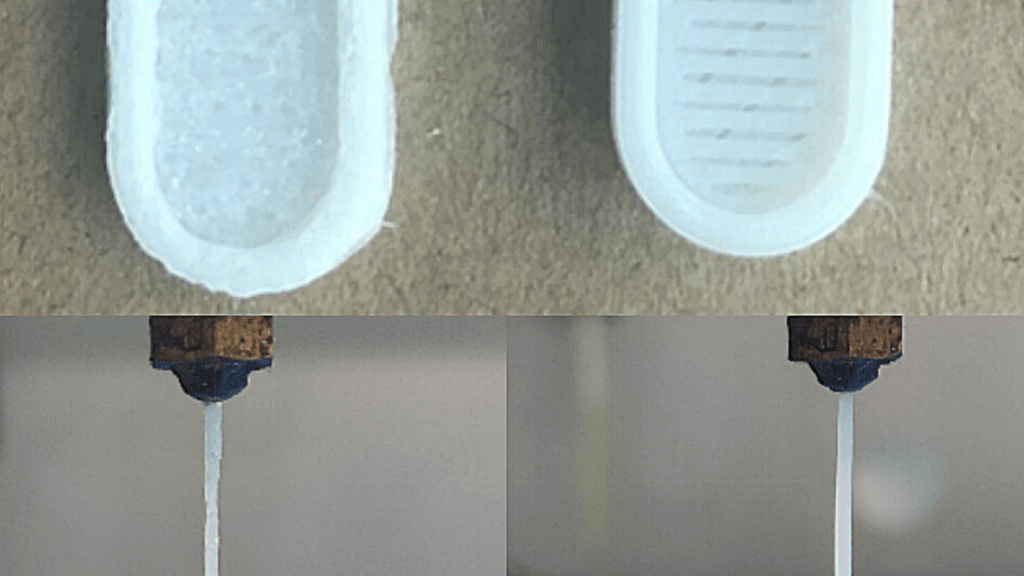
Image: Curry Lin (EIBOS Lab)
He also listed filament drying methods and differences, including using desiccant dehumidifiers only, PI heating pads, and enclosed filament dryers, and he listed the pros and cons of each technique.
The Best Filament Dryers
Here, we will list the best filament dryers available on the consumer market for FDM 3D printers. Some are more expensive and sophisticated, while others are best for space and budget.
SUNLU S2 Filament Dryer
Price: $69-79
Product links:
Amazon
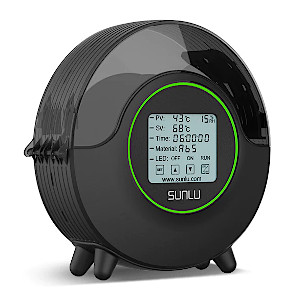
This is the second filament dryer from SUNLU, the S2, which stands out with its futuristic look. It has a compact build and a large touchscreen display, and it presents many metrics, including temperature, moisture, target temperature, timer, and material type. The settings are easy to see and use. With a maximum temperature that can be increased up to 70°C, the S2 can now dry a wider range of materials, such as PLA, ABS, Nylon, and more.
This build enables the filament to be fed to our Creality 3D printers. For the Ender 3 V2 Neo, the filament feed is straightforward and even safer than using the original spool holder on the top. It eliminates the risk of brittle filament snapping. The Ender 5 S1 also works well with this setup, even though its filament feeding mechanism is slightly unusual. Refer to the Ender 5 S1 review article for more details.
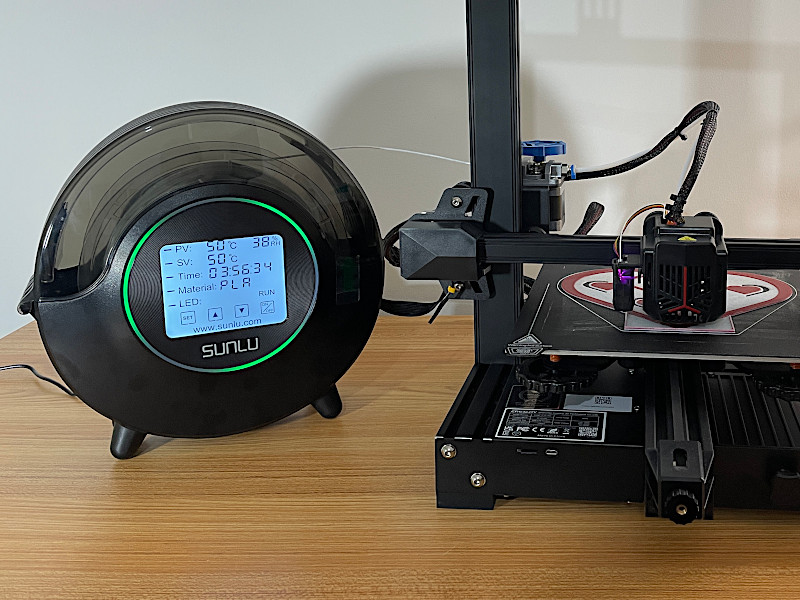
©3DWithUs – Photo: Max Funkner
360° Heating: The heating element covers 360 degrees around the spool, unlike the previous version, which only covered 50% of that area. This machine does not require a desiccant dehumidifier, as it is not needed. This feature is quite convenient, as there is no need to worry about drying or replacing desiccant bags in the future.
SUNLU FilaDryer SP2
Price: $69.99-$99.99
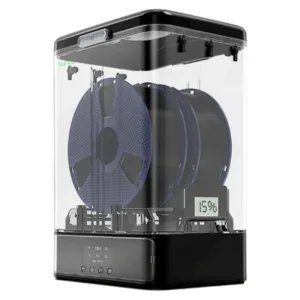
Compare the Prices & Bundles:
Official Store
SUNLU, a well-established name in the 3D printing industry, has expanded its lineup with the FilaDryer SP2. It’s an airtight, modular system designed to store and dry filament more efficiently, capable of accommodating two 1kg spools, or one 2kg or 3kg spool.
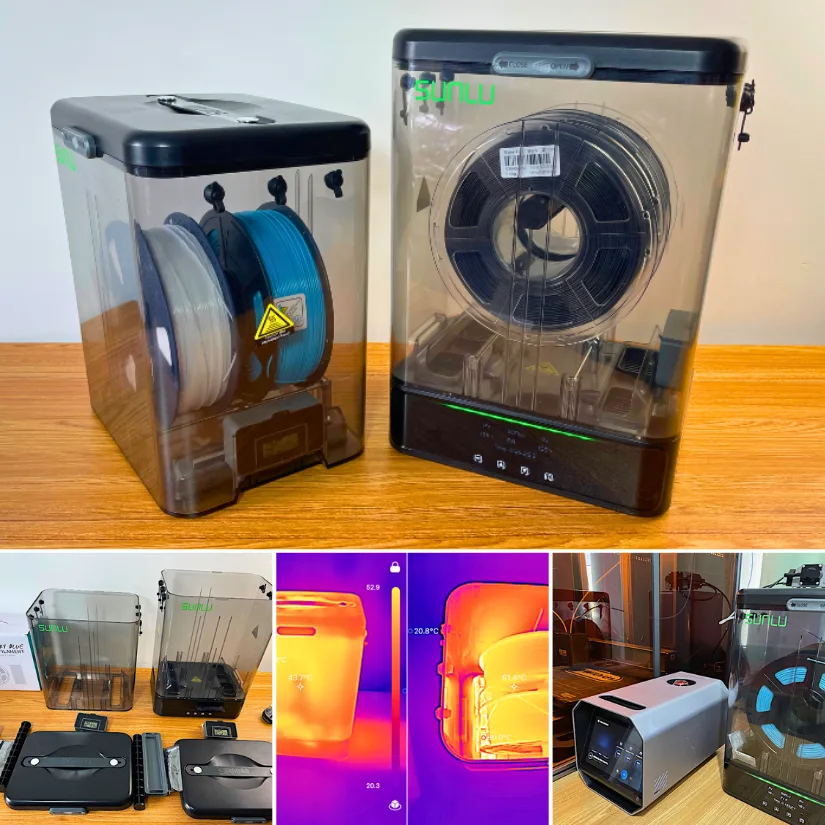
©3DWithUs – Photo: Max Funkner
The FilaDryer SP2 is SUNLU’s answer to a modular, airtight storage and drying solution. I’ve used the device extensively and have been pleased with its performance. The storage boxes are relatively large – designed to accommodate spools up to 3 kg, as well as standard 1 kg spools. Any remaining space can be effectively used for extra desiccant bags to enhance drying and humidity control.
Read more:
FilaDryer SP2 Review and Pros & Cons by Max Funkner.
SUNLU FilaDryer S4
Product links:
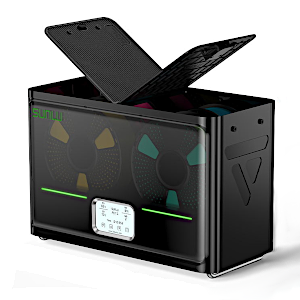

SUNLU keeps bringing filament maintenance solutions to the market. Their latest product, the SUNLU FilaDryer S4 filament dryer, can accommodate and dry up to four 1kg spools at once.
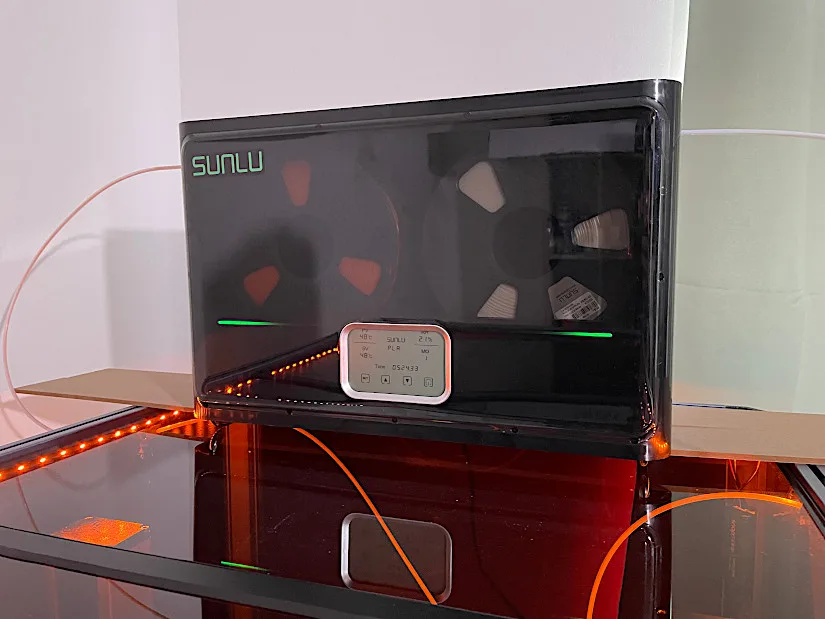
©3DWithUs – Photo: Max Funkner
Generally, I am pleased to have FilaDryer along with my FDM 3D Printers. Over the years, I’ve accumulated a lot of half-empty spools that have lost their quality due to humidity. Now I can refresh them four spools at once. It is definitely a good device for FDM 3D printer workshops. Also, it can be a fancy alternative to a filament storage box for casual 3D printer users as well.
Read more:
FilaDryer S4 Review and Pros & Cons by Max Funkner.
SUNLU FilaDryer E2 NEW
Price: $279 – $339
Product links:
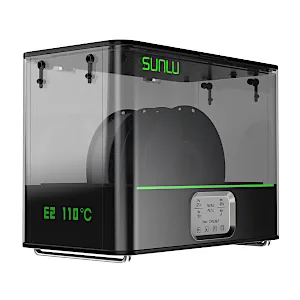

A year after SUNLU successfully launched the FilaDryer S4, the company introduced the FilaDryer E2, a two-spool solution designed for engineering-grade materials like ABS, PA(Nylon), CF(Carbon Fiber), and other higher-temperature filaments. This new device also features a second novel function: an annealing mode for post-processing, which boosts the properties of 3D-printed parts.
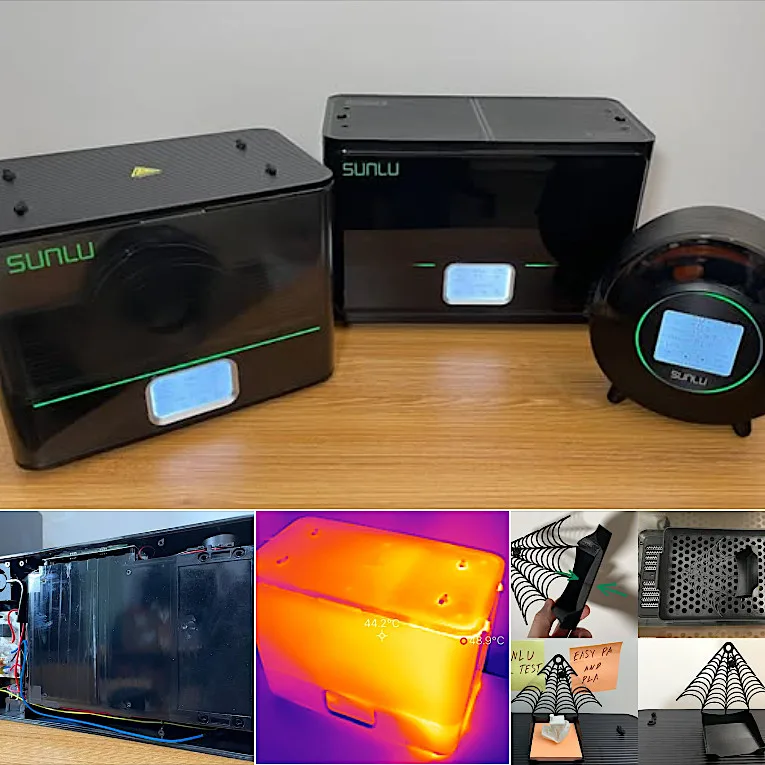
©3DWithUs – Photo: Max Funkner
SUNLU is steadily building its reputation as a specialist in 3D printing materials. The FilaDryer E2 is a testament to its pioneering spirit. This innovative product addresses the evolving demands of the 3D printing community.
Read more:
FilaDryer E2 Review and Pros & Cons by Max Funkner.
Polymaker PolyDryer NEW
Price: $79.99
Product links:
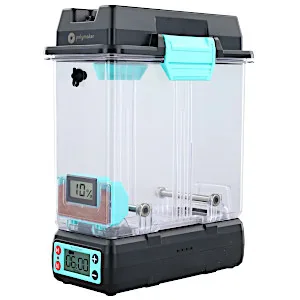

Polymaker’s PolyDryer was co-developed and beta-tested with the help of some members of the 3D printing community.
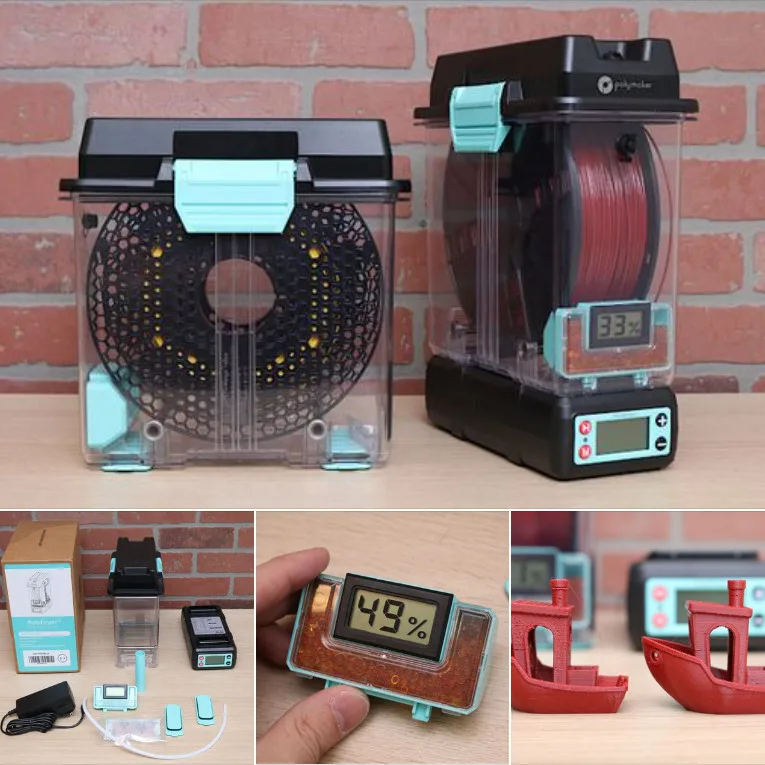
©3DWithUs – Photo: Andrew Sink
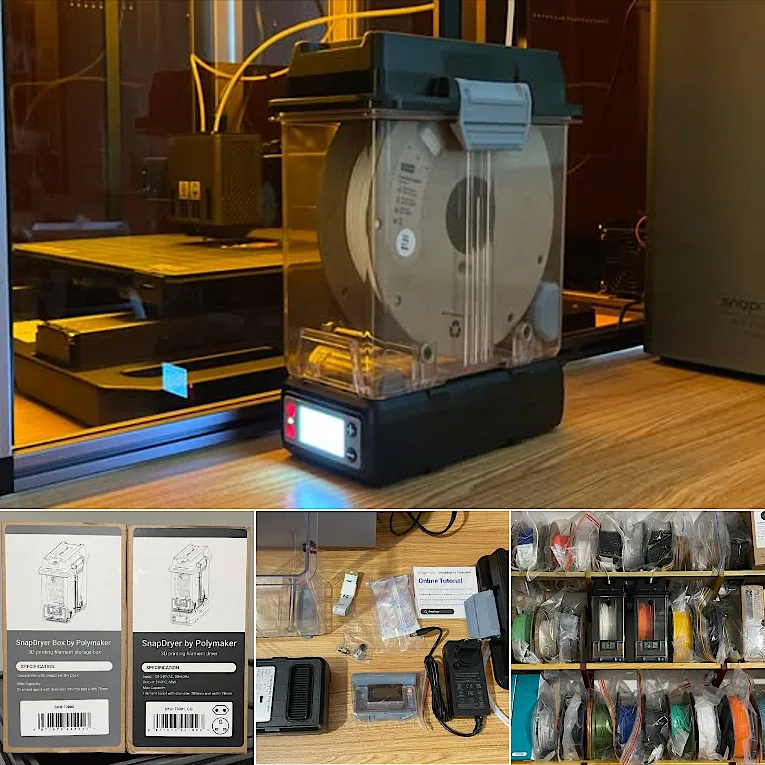
©3DWithUs – Photo: Max Funkner
I was impressed by the PolyDryer and would not hesitate to recommend it as a useful tool that can pay for itself quickly. The PolyDryer is an easy purchase to justify for print farms as well as hobbyists who just want to prepare their material immediately before printing. The modular PolyDryer Box system can be used to store material between uses, and the visual indicator of the hygrometer on the front of the unit gives an at-a-glance status update on the condition of the material. Andrew Sink
Read more:
Polymaker PolyDryer Review by Andrew Sink.
Polymaker & Snapmaker SnapDryer Review by Max Funkner.
EIBOS Cyclopes
Price: $99-120
Product links:
Amazon
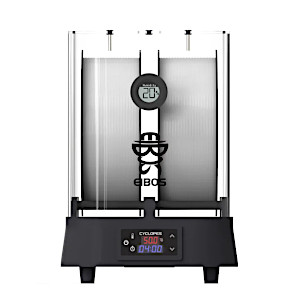
EIBOS CYCLOPES, launched via Kickstarter, was one of the first products to address humidity issues. It works as a fully heated option without the need for desiccant dehumidifiers. Also, CYCLOPES offers more control with adjustable heating temperature and heating time. The bigger box may hold two 1kg spools or one 3kg filament spool.
EIBOS Polyphemus
Price: $119-159
Product links:
Amazon
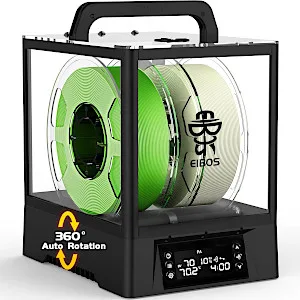
EIBOS Polyphemus (inspired by the Ancient Greek one-eyed giant) is the latest addition to the filament dry box lineup by EIBOS. Building upon the success of its predecessor, Cyclop, this advanced device incorporates cutting-edge features, including a 360°C automatic rotating heating system, an extra-large capacity for two 1KG spools or a single 3KG spool, and automated humidity and temperature control for optimal filament storage.
EIBOS Series X Tetras
Price: $175 – $194
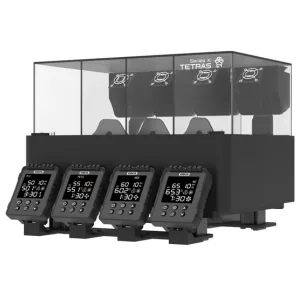
The EIBOS Series X Tetras is a well-thought-out upgrade for users already running a Bambu Lab AMS. Instead of adding yet another standalone dryer to your setup, the Tetras integrates directly with your existing system, offering independent drying bays without compromising on space or performance.
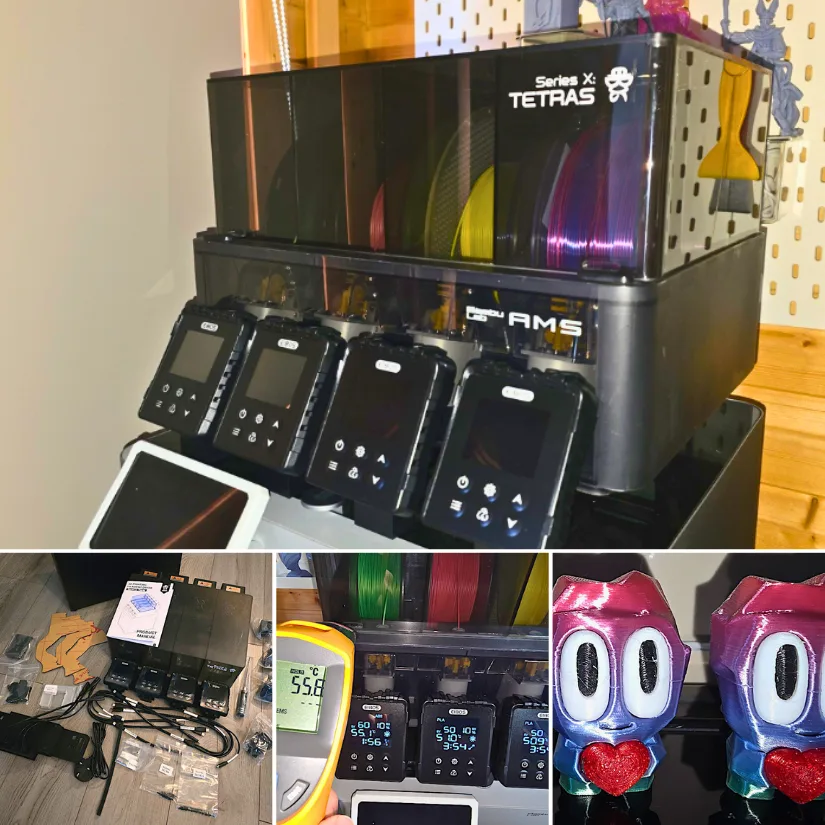
©3DWithUs – Print and Photo: Phil Macey
This article is based entirely on my own hands-on experience setting up and running the Tetras on a Bambu Lab X1C. Below, you’ll find a full walkthrough of the installation process, along with real-world print tests and performance results. A summary with Pros and Cons is available at the end of the article for quick reference.
Read more:
Upgrading Bambu Lab AMS with the EIBOS Series X Tetras Dryer by Phil Macey.
Creality Space Pi, Space Pi Plus and Spice Pi X4 NEW
Price: $69-89
Product links:
Amazon
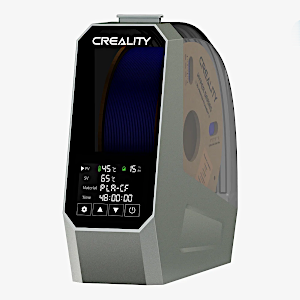
Pre-Order: Creality Space Pi Plus – Two Rolls Capacity Filament Dryer
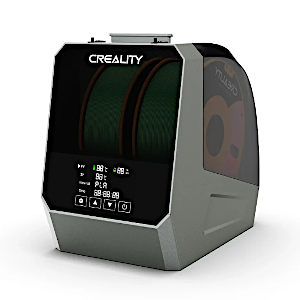
Creality, a well-known brand in the consumer 3D printing market, has recently introduced an update and upgrade to their filament dryers, unveiling the Space Pi and Space Pi Plus; the latter is currently available for pre-order. These innovative dryers serve a practical function and boast a distinctive design appeal, setting them apart in the market. The Space Pi Plus features user-friendly One-Key Settings on its screen, simplifying the process for managing different types of filaments such as PLA, PETG, ABS, TPU, and Nylon. Additionally, the dryer is designed with a 360-degree air circulation system, ensuring efficient and even drying of filament materials.
Spice Pi X4
Price: $159
Compare the Prices & Bundles:
Official Store | Amazon | AliExpress
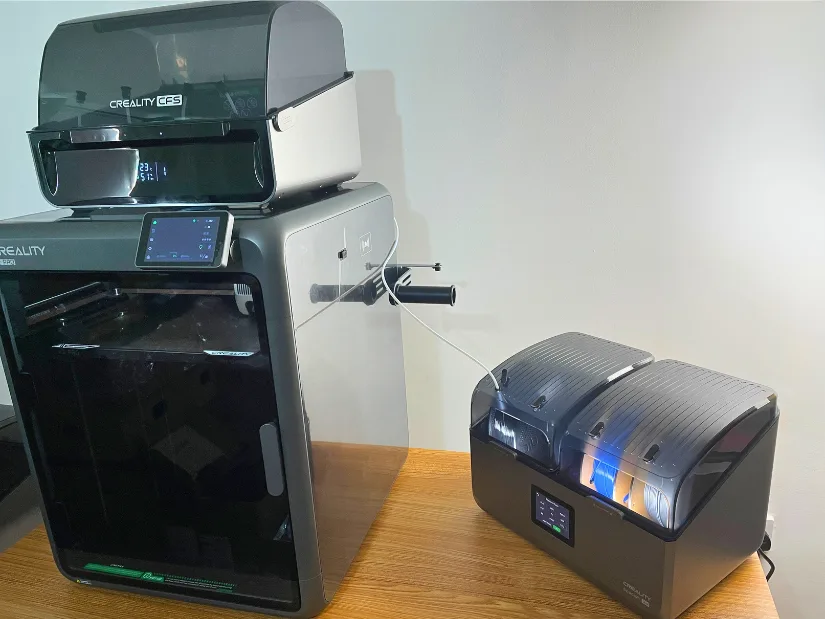
I especially appreciated the airtight separate chambers. As shown in the image, one chamber can dry PLA at 50 °C while another handles TPU at 60 °C, each tailored to the material’s needs. What’s more, the system allows you to leave filaments inside and check the humidity levels the next time before starting a new print. This adds both reliability and convenience for anyone working with sensitive engineering-grade filaments.
Sovol SH01 Filament Dryer Box
Price: $37-59
Product links:
Amazon
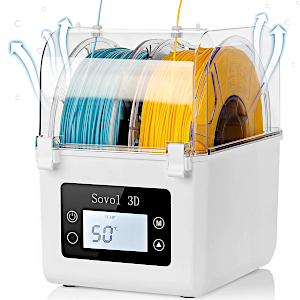
FDM 3D printer manufacturer Sovol offered their own version of a filament dryer. This product can hold two spools at a time and displays both temperature and humidity levels. The simplistically designed box is easy to use and has a good seal, keeping the box tightly closed. It is shipped as an upgraded version with an improved fan.
Eryone M1, M2 – Dryer Box Snail
Price: $38-59
Product links:
Amazon
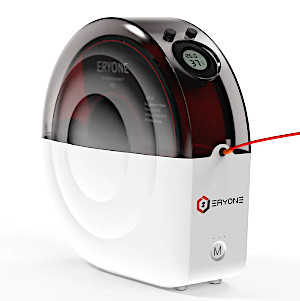
Eryone M1 has a slim, snail-like design that has surprisingly many functions. It combines drying with the help of desiccant dehumidifiers and a heating option.
It was delivered in a box slightly bigger than a 1kg filament spool. It is designed to hold the standard 750g-1000g spools, but when I tested a smaller spool, it also worked. The smooth metal base surface and relatively light weight of the spool allowed it to roll in the box.
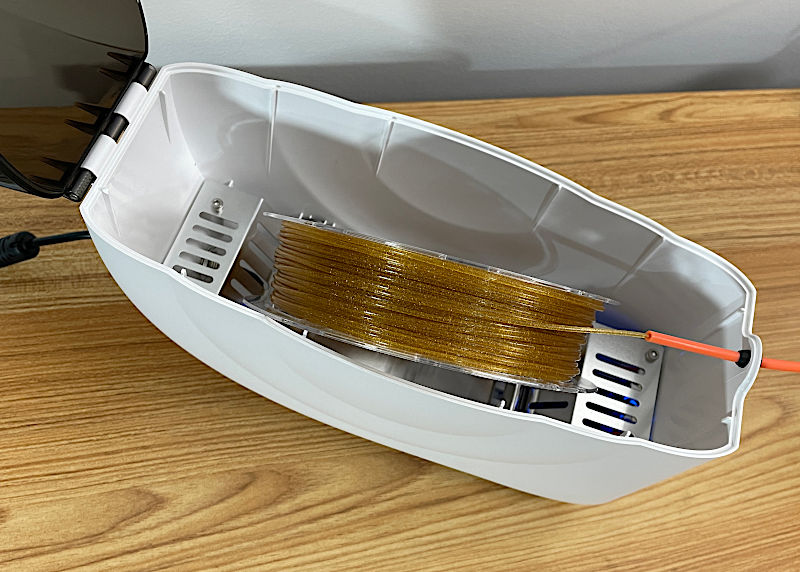
©3DWithUs – Photo: Max Funkner
It took us about one day to decrease humidity from 46% to 24%. We had to switch the heating function back on several times because it stays on for four hours. The Bowden extruder-setup 3D printer, like Neptune 3, worked well.
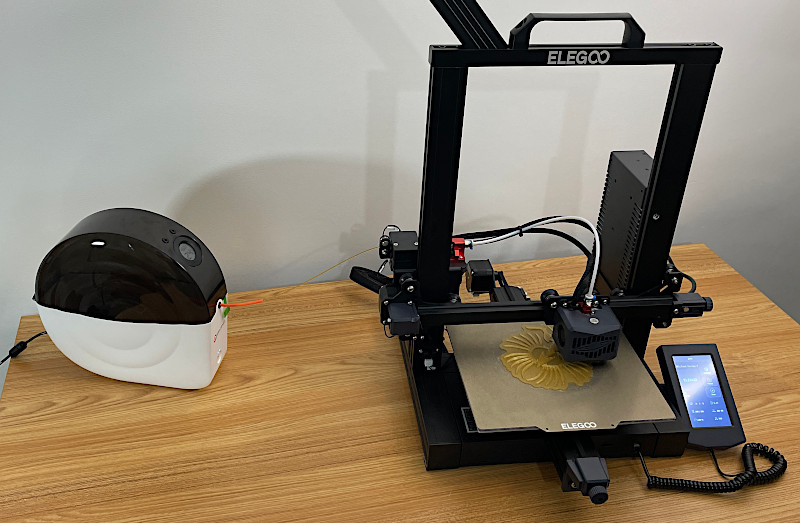
©3DWithUs – Photo: Max Funkner
Filament dryers with such a compact design could be the best solution for those with a limited budget and space.
DIY Solutions and Innovations
Even though many 3D printing-related brands launched filament drying products, many DIY solutions and tutorials are available online. These may look less appealing, but they are sometimes as effective as the commercial versions. Also, cost-wise, these are much cheaper to build, and volume-wise, they are more productive.
– IKEA Storage Box. Following one of the first results in a Google search, we found a video on how to turn an IKEA storage box into an effective dry box. Generally, many storage boxes and food containers that can be turned into dry boxes can be found online.
– High-Temperature and Annealing. High-temperature filament dryers enable the maintenance of advanced engineering-grade materials like PA-Nylon, PC-ABS, ASA, and CF-Carbon Fiber blends. The annealing post-processing feature allowing users to experiment and post-process filaments and prints in a controlled environment.
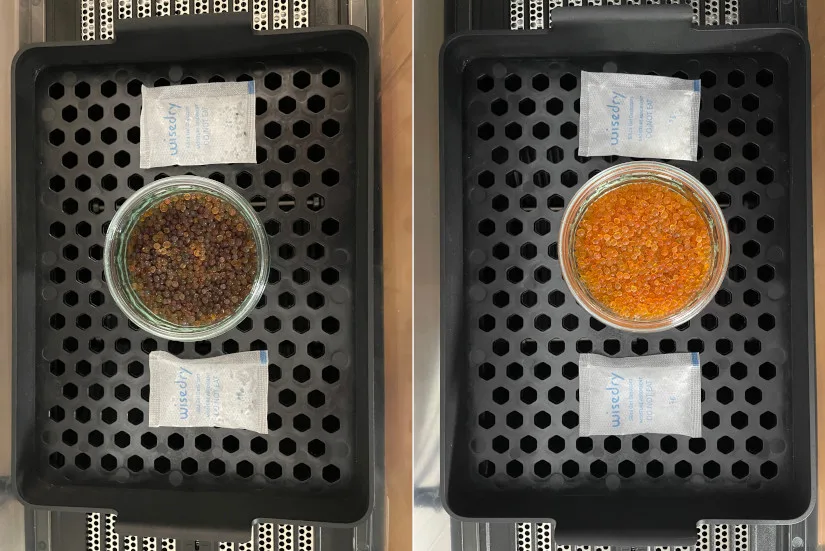
©3DWithUs – Photo: Max Funkner
No more invading the kitchen! Using the FilaDryer E2, for example, it is possible to dry loose desiccant and sachets in approximately 30 minutes on full power. While this can be done faster in a regular microwave on defrost mode, having the option to do it in the workshop is highly convenient.
– RepBox System. This system was initially designed to protect multiple filament spools, such as dust, from the environment. It also helps arrange multiple spools for multi-material 3D printing. Another great benefit of this product is that it can be installed on the wall and, therefore, saves space on the table. According to the manufacturer, it does provide some protection from moisture if desiccant dehumidifier packets are added. Check RepBox products at Repkord.
Filament Storage Bags with Electric Pumps
Storage bags are a popular method for keeping filament dry, and even simple food bags with a few desiccants can work in the short term. But over time, mishandling, weak seals, or unnoticed desiccant failure can compromise spool quality.
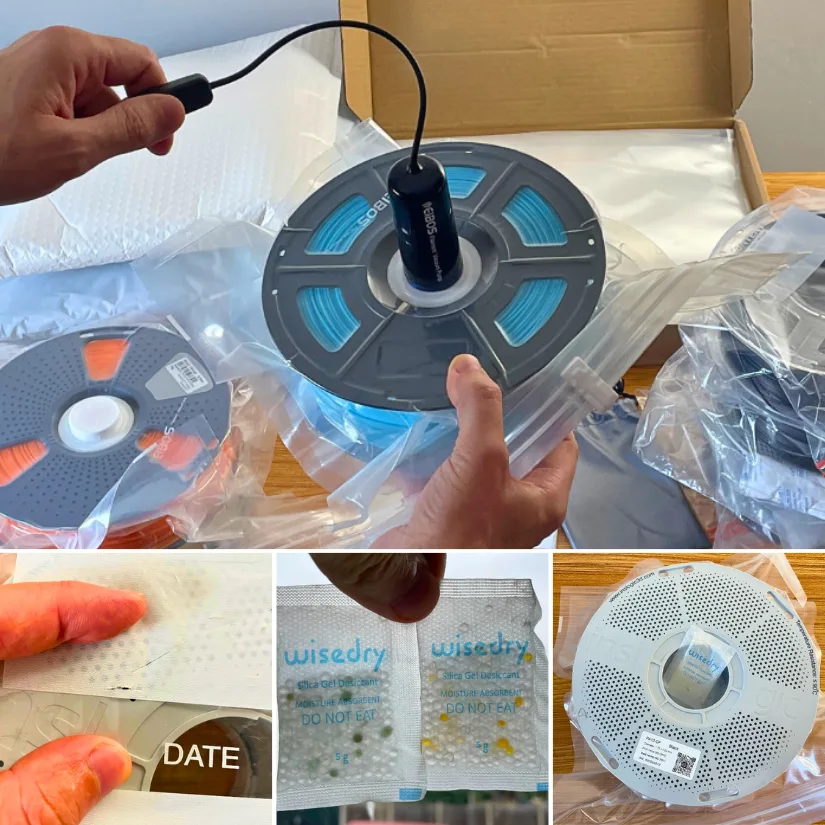
©3DWithUs – Print and Photo: Max Funkner
For a more reliable setup, explore purpose-made kits on Amazon and check out our full guide with tests and tips: Best Filament Vacuum Pumps & Reusable Storage Bags.
Conclusion
Filament dryers can help both casual and professional 3D printer users, especially in situations with high air humidity. I would keep one of these machines handy to maintain and keep filaments in the best shape. I also added a filament dryer as an optional tool for FDM 3D printers to the ever-expanding list.

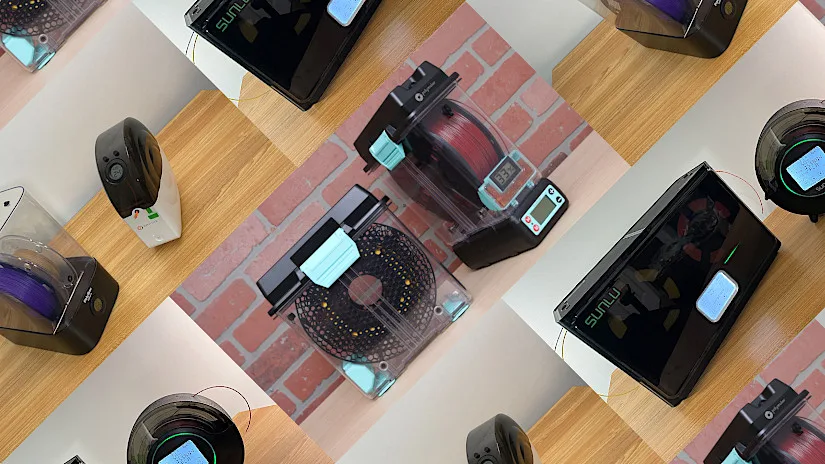


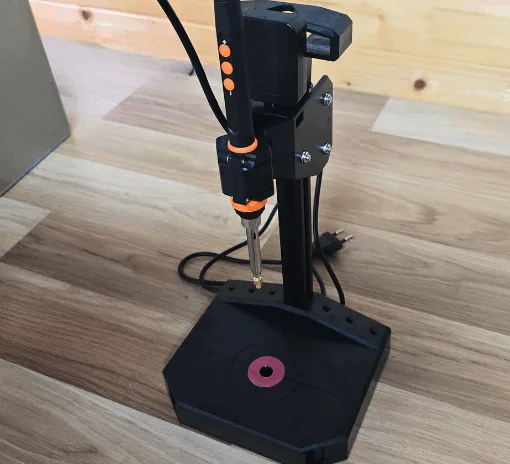
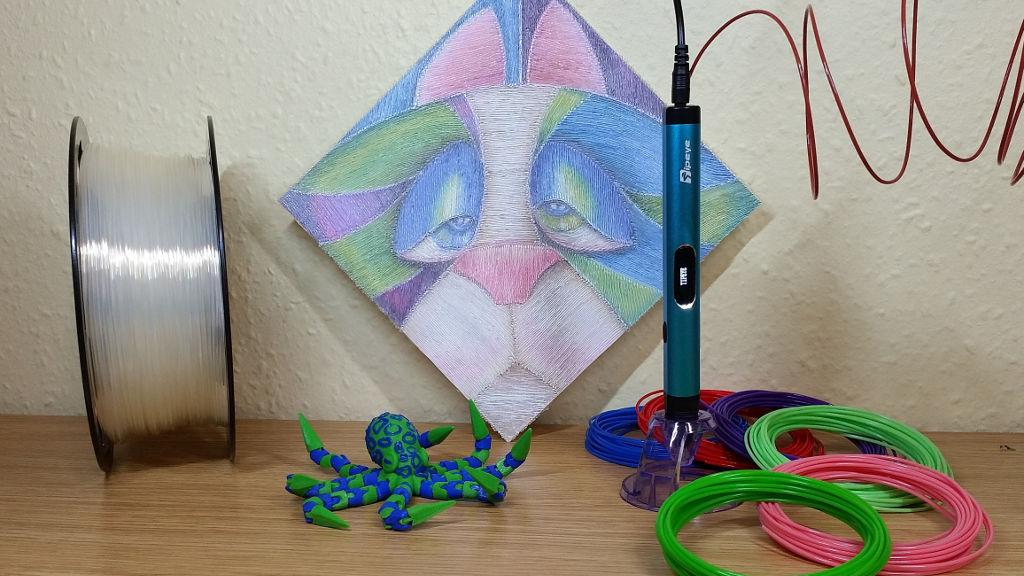
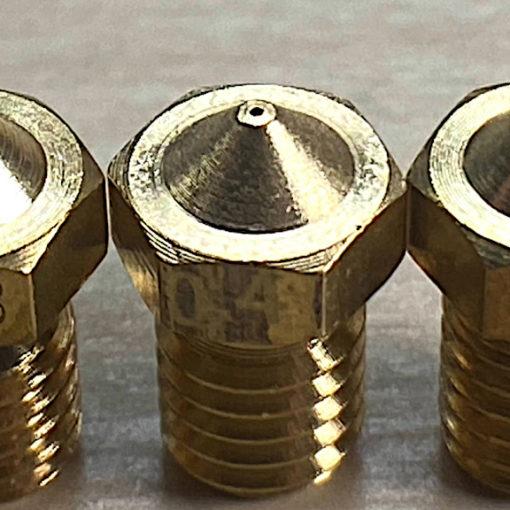

What you need is a simple chart that compares features, like max temp, max spool size, # of spools, desiccant needed, time to dry from 45% to 20% RH, modular spool storage (without a heater in the box), always-on mode (to keep humidity under a specified RH for a duration), retail cost, and perhaps a dozen more.
I don’t see the max temps anywhere on this page, so I don’t know if each unit would suit higher temp filaments. Even ABS is 70C and the polymakers go to 60C, but claim that they dry ABS — curious.